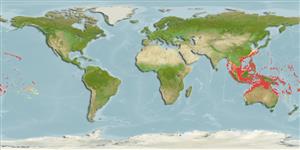>
Mulliformes (Goatfishes) >
Mullidae (Goatfishes)
Etymology: Parupeneus: Latin, parum, parvum = small + Peneus, the name of a river.
More on authors: Quoy & Gaimard.
Environment: milieu / climate zone / depth range / distribution range
Écologie
marin récifal; profondeur 0 - 161 m (Ref. 54393). Tropical; 30°N - 32°S, 92°E - 132°W
Pacific Ocean: Christmas Island in the eastern Indian Ocean to the Hawaiian, Line, Marquesan, and Tuamoto islands, north to southern Japan, south to Lord Howe and Rapa Islands.
Length at first maturity / Taille / Poids / Âge
Maturity: Lm 11.0, range 14 - ? cm
Max length : 35.0 cm TL mâle / non sexé; (Ref. 48636); 17.9 cm SL (female); common length : 20.0 cm TL mâle / non sexé; (Ref. 9947); poids max. publié: 453.00 g (Ref. 4887)
Épines dorsales (Total): 8; Rayons mous dorsaux (Total): 9; Épines anales 1; Rayons mous anaux: 7. Diagnosis: Pectoral rays 16 (rarely 15 or 17). Gill rakers 7-10 + 28-33 (total 36-41). Body depth 3.1-3.65 in SL; head length (HL) 2.8-3.1 in SL; dorsal profile of snout straight to slightly concave, the length 1.65-1.95 in HL; barbels long, their length 1.0-1.3 in HL; longest dorsal spine 1.5-1.75 in HL; last dorsal soft ray notably longer than penultimate ray, the latter contained 1.15-1.45 in length of the former; posterior margin of caudal-fin lobes convex; pectoral-fin length 1.35-1.55 in HL; pelvic-fin length 1.25-1.45 in HL. Body gray to red, the margins of the scales often yellow, with a broad black bar on caudal peduncle and one beneath anterior part of second dorsal fin, the area between bars paler than rest of body (sometimes white); a narrow dusky bar often present below interdorsal space, and one or two broad dark bars may be present anteriorly on side of body; head usually with a dark brown band from above upper lip through eye to upper end of gill opening; caudal fin yellowish to pink with narrow blue lengthwise bands; basal half of second dorsal fin of adults dusky anteriorly, black posteriorly, the outer half with narrow dark-edged blue and yellow bands; anal fin like outer part of second dorsal fin (Ref. 54393).
This occasionally schooling species occurs over sand patches as well as rubble, consolidated limestone, or coral bottoms from reef flats and shallow lagoons (Ref. 1602). Benthopelagic (Ref. 58302). Feeds primarily on small crabs and shrimps during the day (Ref. 1602), also demersal fish eggs, mollusks, and foraminiferans (Ref. 37816). Minimum depth reported taken from Ref. 128797.
Randall, J.E., 2004. Revision of the goatfish genus Parupeneus (Perciformes: Mullidae), with descriptions of two new species. Indo-Pac. Fish. (36):64 p. (Ref. 54393)
Statut dans la liste rouge de l'IUCN (Ref. 130435)
Menace pour l'homme
Harmless
Utilisations par l'homme
Pêcheries: commercial; pêche sportive: oui; Aquarium: Commercial
Plus d'informations
RéférencesAquacultureProfil d'aquacultureSouchesGénétiqueElectrophoresesHéritabilitéPathologiesTraitementNutrientsMass conversion
Outils
Articles particuliers
Télécharger en XML
Sources Internet
Estimates based on models
Preferred temperature (Ref.
123201): 23.8 - 28.9, mean 27.3 °C (based on 584 cells).
Phylogenetic diversity index (Ref.
82804): PD
50 = 0.5000 [Uniqueness, from 0.5 = low to 2.0 = high].
Bayesian length-weight: a=0.01288 (0.01042 - 0.01593), b=3.10 (3.07 - 3.13), in cm total length, based on LWR estimates for this species (Ref.
93245).
Niveau trophique (Ref.
69278): 3.5 ±0.3 se; based on diet studies.
Generation time: 1.5 ( na - na) years. Estimated as median ln(3)/K based on 1
growth studies.
Résilience (Ref.
120179): Haut, temps minimum de doublement de population inférieur à 15 mois (K=0.756; Fec = 7,929).
Fishing Vulnerability (Ref.
59153): Low vulnerability (21 of 100).
Nutrients (Ref.
124155): Calcium = 38 [18, 86] mg/100g; Iron = 0.353 [0.177, 0.770] mg/100g; Protein = 17.9 [14.5, 21.0] %; Omega3 = 0.141 [0.077, 0.262] g/100g; Selenium = 74.2 [34.5, 183.9] μg/100g; VitaminA = 136 [27, 622] μg/100g; Zinc = 0.52 [0.31, 1.01] mg/100g (wet weight);
